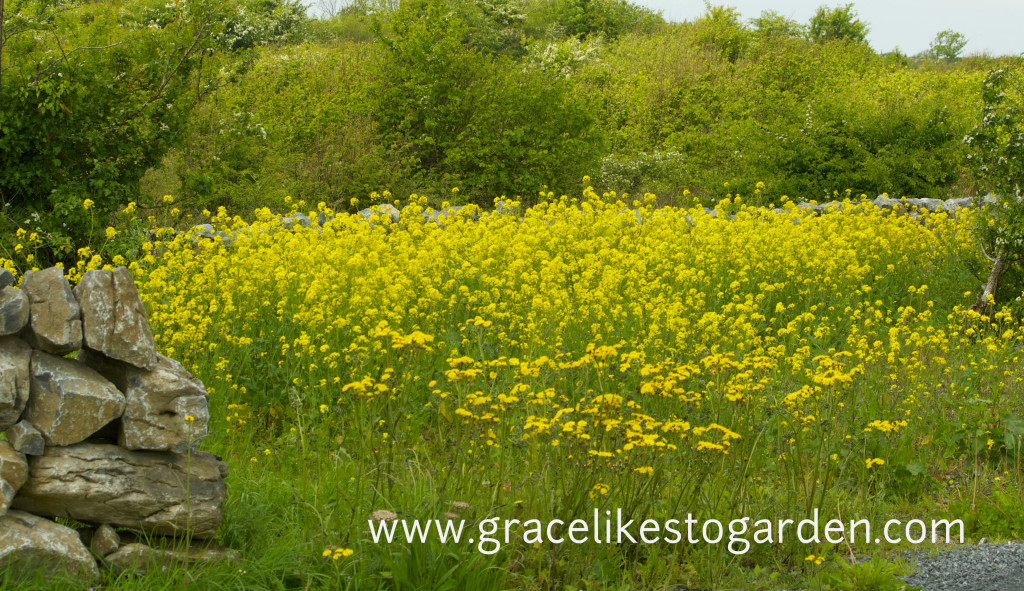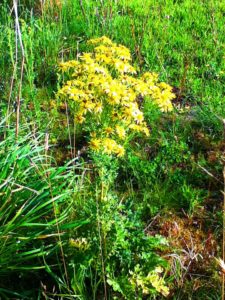 RAGWORT – A MARE’S WHAT?
RAGWORT – A MARE’S WHAT?
Part of this coming bank holiday weekend is going to be dedicated to removing from my garden a certain Ragwort.
Ragwort is blessed with many names these include: St. James-wort, Ragweed, Stinking Nanny/Ninny/Willy, Staggerwort, Dog Standard, Cankerwort, Stammerwort, or the equally charming Mare’s Fart.
With names like that Ragwort must have been loved once but here in Ireland, we think of Ragwort as a horrible weed, toxic, allergy-causing and a pain in the neck to get rid of.
THE RAGWORT FORMERLY KNOWN AS A HORRIBLE WEED
Yet, this quite pretty yellow flower wasn’t always so maligned. In fact, the ragwort is far from just a horrible weed. It is actually the national flower of the Isle of Man and if that’s not enough to redeem this plant in your eyes then get this – in 1831 poet called John Clare, fell so in love with its mellow yellow beauty that he wrote this poem in its honour.
Ragwort thou humble flower with tattered leaves
I love to see thee come & litter gold…
Thy waste of shining blossoms richly shields
The suntanned sward in splendid hues that burn
So bright & glaring that the very light
Of the rich sunshine doth to paleness turn
& seems but very shadows in thy sight.
John Clare
A RAGWORT IN THE EYE AND THE KNEE AND THE TOE AND THE ELBOW AND THE…
Beautiful! Not only is Ragwort a national flower and subject of poetry, but Ragwort was also known for its medicinal qualities.
History tells us it was used against eye inflammation, cancerous ulcers, rheumatism, sciatica, gout and painful joints. (This is not medical advice – we now know this is poisonous – stay away from Ragwort!) See wikipedia article here.
Another less known snippet of information about Ragwort is a story told by Donald Macalastair of Druim-a-ghinnir on the Isle of Arran.
Apparently, the Ragwort was used as transport by fairies travelling to Ireland. Every one of them picked a plant, sat astride and arrived in Ireland in an instant. Now that’s the way to travel!
Yet despite all this, Ragwort is now regarded as toxic and noxious.
Far from being celebrated here, it is actually included under the Noxious Weeds (Thistle, Ragwort and Dock) Order 1937 issued under the Noxious Weeds Act 1936 – landowners are required to control its growth.)
Teagasc say that ‘Ragwort is a highly poisonous plant if eaten. Ragwort is toxic to cattle, horses, deer, goats, pigs and chickens,’
Still, I can’t help but notice Ragwort, although a poison, is a beautiful poison and Ragwort is flowering everywhere at the moment.
The roads around Kinvara are glowing with yellow which is lovely as I had begun to miss the vibrant wakefulness of the colour yellow around the place after the sad demise (until next year) of the gorse.
However, somewhere else that is glowing with yellow is my so-called wildflower meadow (getting wilder by the second.)
Two weeks ago there appeared to be only one Ragwort but all of a
 sudden I am seeing them everywhere.
sudden I am seeing them everywhere.
They have sprouted as though from some spontaneous combustion of weeds and there is only one thing for it – we are going to have to get rid!
According to Teagasc, the only way is to ‘safeguard against loss from ragwort poisoning is to eradicate the weed either by pulling, ploughing, cutting or chemical control.’
Due to my own allergies, we are not going to try the chemical route.
So, instead, the plan is that M will remove the heads to prevent seeding, double bag the offending heads of seeds, pull the plants and bag them while I remain safely around the raised beds where so far no ragwort has shown its pretty face.
So hopefully this weekend will say bye bye to the ‘humble flower with tattered leaves.’ Though I’m sure John Clare will be turning in his grave.
So long, lovely Ragwort.
Grace
P.S. See below for a great way to share your love of nature with your children.
HOW TO ENCOURAGE YOUR CHILDREN TO LOVE NATURE
MAGGIE MANY CATS
Besides gardening, I also love to write. I used to write for Ireland’s RTE 1 children’s radio. I now write with the aim of encouraging children to love nature.
 I wrote my series of Ballyyahoo children’s books to share my love of nature with young readers.
I wrote my series of Ballyyahoo children’s books to share my love of nature with young readers.
Each book in the series includes links to my Ballyyahoo website.
Interested children can click in various places throughout the stories and be brought straight to the website where they will find information and photographs about nature.
If you want to encourage your children to learn more about nature and wildlife while enjoying a fun story – this is an easy and spontaneous way to do it.
TAKE A WANDER AROUND BALLYYAHOO
GET MAGGIE MANY CATS AND OTHER STORIES FROM AMAZON.COM









Recent Comments